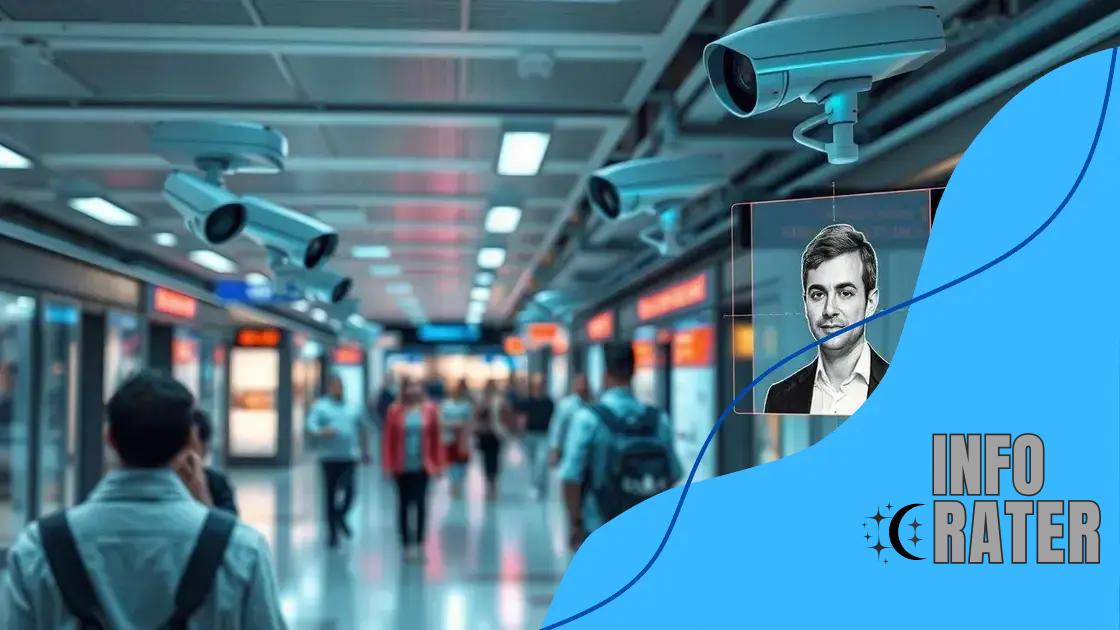The role of facial recognition in enhancing public safety

The role of facial recognition in enhancing public safety involves improving security measures, facilitating quick identification in emergencies, and supporting crime deterrence through advanced technology applications.
The role of facial recognition in enhancing public safety is becoming increasingly significant. With its ability to identify individuals quickly, how can this technology transform our approach to security?
What is facial recognition technology?
Facial recognition technology is a fascinating and evolving field that has the potential to change how we interact with security systems. This technology enables computers to identify or verify a person’s identity using their facial features. It works by capturing images of a face and comparing them against a database. This process can be performed in real-time.
How does facial recognition work?
The technology relies on advanced algorithms that analyze facial characteristics. These algorithms search for unique features such as the distance between the eyes, the shape of the jaw, and other distinctive traits. When a new image is captured, it is converted into a set of points that represent the face, creating a digital signature.
Applications of facial recognition technology
This technology has various applications that enhance public safety. Here are a few notable uses:
- Surveillance in public spaces to identify potential criminals.
- Access control for secure areas, like airports or government buildings.
- Finding missing persons through public database searches.
Facial recognition technology is continually improving, making it more accurate and efficient. Its increasing implementation in various sectors shows how beneficial it can be. However, it is essential to consider the ethical implications of such advancements.
Ethical considerations
As with any technology, facial recognition raises concerns regarding privacy and consent. People often worry about the unauthorized use of their images and potential surveillance overreach. Addressing these concerns is vital to the continued development and acceptance of this technology.
In conclusion, facial recognition technology is a powerful tool that can significantly contribute to public safety and security. Understanding how it works and its implications helps us navigate its future responsibly.
Benefits of facial recognition in public safety
The benefits of facial recognition in public safety are significant and wide-ranging. This technology enhances security measures by allowing authorities to identify individuals quickly. It reduces response times in emergencies by pinpointing suspects and facilitating a faster police response.
Improved Security Measures
One of the primary advantages of using facial recognition is the heightened level of security in public spaces. By implementing this technology in crowded areas, security teams can monitor potential threats effectively. This has led to safer environments, especially in places like airports and stadiums.
Crime Deterrence
The presence of facial recognition systems often acts as a deterrent against crime. Knowing that surveillance is in place can discourage individuals from committing illegal activities. Criminals are less likely to engage in wrongdoing if they understand that they can easily be identified.
- Reduction in theft and vandalism.
- Increased likelihood of apprehending offenders.
- Enhanced trust from the community towards law enforcement.
In addition to deterring crime, facial recognition helps in locating missing individuals. When a system is connected to missing persons’ databases, it can quickly identify someone reported missing, thereby aiding recovery efforts. This application saves valuable time and resources in emergency situations.
Enhanced Efficiency
Another important benefit of facial recognition is the efficiency it brings. Security personnel can spend less time searching for potential threats and more time focusing on maintaining public order. By automating identification processes, authorities can allocate resources strategically, improving overall safety.
Moreover, this technology can assist during large gatherings or events, ensuring that law enforcement is aware of any potential issues before they escalate. Implementing facial recognition in safety protocols leads to smarter, more proactive policing that enhances overall community safety.
Challenges and ethical concerns

While the advancements in facial recognition technology bring notable benefits, they also create significant challenges and ethical concerns that we must address. As this technology becomes more prevalent, it has sparked debates about privacy, consent, and potential misuse.
Privacy Issues
One of the major challenges is the concern over privacy. Many people worry about being constantly monitored in public spaces. The idea of cameras capturing and analyzing their faces can feel intrusive. This raises the question: how much surveillance is acceptable in the name of safety?
Consent and Data Use
Facial recognition often operates without individuals’ consent, leading to ethical dilemmas. People may not be aware that their images are being collected and used for identification. This lack of transparency can diminish trust between the public and authorities.
- How data is stored and secured is also crucial.
- Potential for abuse by governments or corporations.
- Concerns about inaccuracies impacting innocent individuals.
Another significant concern relates to the potential for racial and gender biases within the algorithms. Studies have shown that some facial recognition systems perform less accurately when identifying people of color and women. This can lead to wrongful accusations and heightens existing social inequalities.
Misuse of Technology
The potential for misuse, including stalking and harassment, is alarming. Criminals could exploit facial recognition technology to track individuals without their knowledge. This makes it essential to implement strong regulations and guidelines to protect citizens.
As we embrace the benefits of facial recognition, balancing these advantages with ethical considerations is critical. Ongoing discussions about legislation and ethical standards are necessary to ensure that this technology serves the public good without infringing on personal freedoms.
Real-world applications of facial recognition
Real-world applications of facial recognition technology are impacting various sectors, showcasing its versatility and benefits. From enhancing security to improving customer experiences, this technology is reshaping how we interact with the world around us.
Security and Surveillance
One of the most prominent uses of facial recognition is in security and surveillance. Many cities now utilize this technology in public spaces, like parks and transportation hubs, to monitor activities and identify suspicious individuals. This application helps law enforcement respond more swiftly to potential threats.
Access Control
Facial recognition is also used in access control systems. For example, many corporate buildings and facilities use this technology to restrict entry to authorized personnel only. With a quick scan of a face, employees can gain access without needing key cards or passwords.
- In airports, it streamlines the boarding process.
- In schools, it enhances safety protocols.
- Wallets use facial recognition for secure transactions.
This technology is revolutionizing the way we think about identification and authorization, making processes more efficient and user-friendly.
Retail and Customer Experience
In retail, facial recognition is enhancing customer experiences. Stores can track customer interactions and preferences using this technology. For instance, when a frequent shopper enters a store, the staff can receive alerts to provide personalized service and recommendations. This level of customization significantly improves customer satisfaction.
Healthcare Applications
Facial recognition is even finding its way into healthcare. Hospitals are using it to identify patients quickly, ensuring that they receive the correct treatment and medication. This reduces errors and improves patient safety during critical moments.
Overall, the potential applications of facial recognition technology are broad and ever-expanding. As the technology evolves, we can expect even more innovative uses that will continue to enhance safety, security, and user experiences across many fields.
Future trends in facial recognition technology
Future trends in facial recognition technology are promising and could change how we interact with various systems. As this technology evolves, we can expect improvements in accuracy, privacy safeguards, and innovative applications across different industries.
Increased Accuracy and Speed
One of the main areas of development is enhancing the accuracy of facial recognition. New algorithms are being created that can identify faces even in challenging conditions, such as poor lighting or at unusual angles. This improvement will make the technology much more reliable in different environments.
Enhanced Privacy Protections
As concerns about privacy continue to grow, future trends will likely include stronger privacy protections. Developers are focusing on creating systems that respect individuals’ rights by giving users more control over their data. This could involve requiring explicit consent before capturing facial images.
- Transparency in data collection practices.
- Options to opt-out of facial recognition systems.
- Better security measures to protect stored images.
These changes could help improve public trust in facial recognition technology, making it easier to implement in everyday life.
Integration with Other Technologies
Another significant trend is the integration of facial recognition with other technologies, such as artificial intelligence and machine learning. By combining these technologies, systems can analyze not just who people are but also their emotions or behaviors. This could lead to personalized experiences in retail and customer service.
In public safety, the integration of facial recognition with smart city infrastructure could improve emergency response times. For example, linking facial recognition systems to emergency services allows for quicker identification and location tracking of individuals in crisis situations.
Expansion into New Industries
As facial recognition technology continues to advance, it will likely spread to new industries. Healthcare, education, and finance are just a few sectors that could benefit greatly from this technology. In healthcare, for instance, facial recognition could streamline patient identification and enhance security within medical facilities.
Overall, the future of facial recognition technology holds many exciting possibilities. As advancements continue, it will shape how we ensure security, enhance user experiences, and safeguard personal information.
FAQ – Frequently Asked Questions About Facial Recognition Technology
What are the main benefits of facial recognition technology?
Facial recognition technology enhances security, improves identification accuracy, and provides personalized experiences in sectors like retail and healthcare.
How does facial recognition work?
It captures and analyzes facial features, creating a digital signature to identify individuals by comparing it against a database.
What are the ethical concerns surrounding facial recognition?
Key concerns include privacy issues, potential biases in recognition accuracy, and unauthorized data collection without consent.
What advancements can we expect in the future of facial recognition?
Future trends include increased accuracy, better privacy protections, and integration with other technologies to streamline processes.





